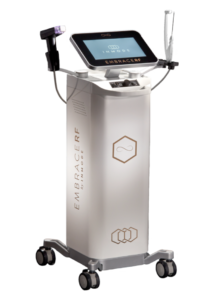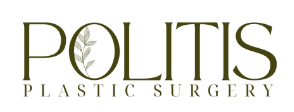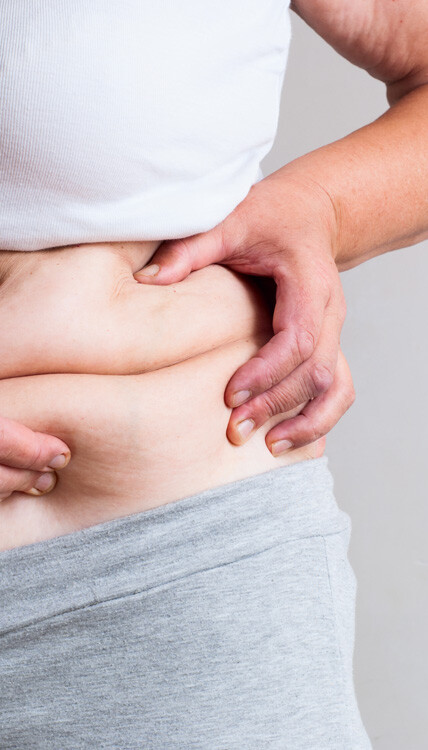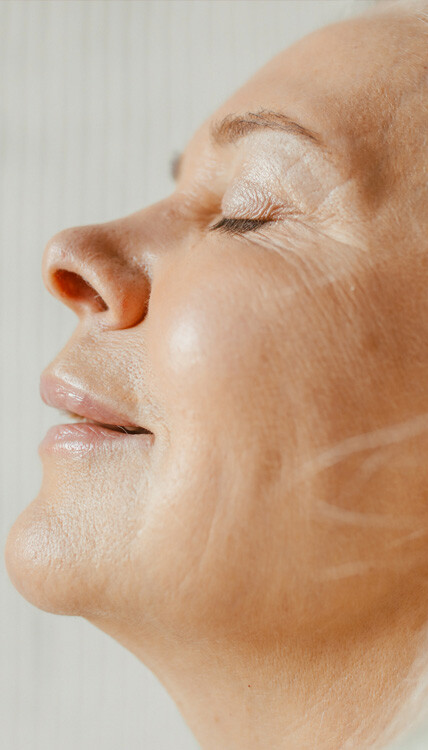A mommy makeover is any combination of cosmetic procedures that restore your before-pregnancy appearance. Learn more at Politis Plastic Surgery.
Continue readingGrowth Factor Serum by ZO® Skin Health
Learn more about the Growth Factor Serum and its benefits by ZO® Skin Health, here at Politis Plastic Surgery.
Continue readingThe Embrace RF Procedure
We’re all vulnerable to aging. And the quality of your face and skin will inevitably slowly degrade with time.

Often when we inspect our face closely we see loose, sagging skin with small pockets of fat all over. Many of us don’t like these inevitable changes and desire the restoration of youth and beauty.
This is why many are choosing the EmbraceRF procedure as a way to achieve a substantial outcome with a relatively modest risk profile compared to more invasive procedures.
So what is the EmbraceRF procedure?
EmbraceRF is a non-surgical, minimally-invasive, FDA-cleared, innovative therapy for producing results closer to facelift surgery. The highly advanced skin-tightening and face-contouring treatment uses radiofrequency energy to deliver a younger, slimmer appearance. With its blend of two top facial rejuvenation treatments—FaceTite and Morpheus 8—EmbraceRF is a multipurpose approach that contours, lifts, and clears the face and skin without surgery or downtime.
It is a perfect option if you don’t want facelift or surgery as it gives permanent results within a shorter time compared to surgery. The results are also more natural-looking and achieved with less scarring. Plus, the procedure takes just 45 to 60 minutes to complete, making it a very convenient solution for tackling facial aging symptoms.
How is it done?
It is performed under local anesthesia or light sedation. During the procedure, your surgeon passes a thin probe with a needle-like entry point under your skin at the treatment site. The probe is used to direct radiofrequency energy to the underlying skin tissue while the skin surface is treated concurrently with a specially-designed hand piece.
EmbraceRF is right for you if you have:
- Neck and face wrinkles
- Deep creases between your mouth and nose
- Sagging skin and neck contour
- Jowls
- Sagging facial skin with little elasticity
- Sagging neck and chin contour
But you should also be in good overall health, a non-smoker, and have realistic expectations.
How does it work?
EmbraceRF applies radiofrequency energy both to the skin surface and to the sub-dermal layers. As the temperature rises above 60 degrees Celsius under the skin, fat dissipates and the skin tightens.
The procedure melts excess fat, contracts the skin, and enhances overall texture; helping to address loose skin in the neck, jowls, and other body areas. It is effective in eliminating stubborn pockets of fat in the neck and facial areas; hence it tightens loose skin, contracts and contours fat, and allows for shaving off of fat in places such as the nasolabial folds, jaw-line, and chin.
By using controlled radiofrequency energy to heat sub-dermal tissue, EmbraceRF helps to reinvigorate collagen production. The newly produced collagen repairs and rejuvenates skin tissue, reducing and eliminating wrinkles to achieve a smoother, fresher skin. In turn, the new collagen helps to make the skin firmer, stronger, and more elastic. This eliminates skin sagging and improves the outline of areas that previously had unsightly, fatty lumps.
Besides, the FaceTite part of the procedure employs tiny incisions made behind the ears and below the skin to deliver a controlled wave of energy, while the Morpheus 8 part blends micro-needling with radiofrequency to provide even more dramatic results.
What are the benefits of the procedure?
EmbraceRF is an effective alternative to surgical facelift. It restores facial contours in a minimally invasive way, therefore it doesn’t lead to scarring. It is specially tailored to tackle facial fat and skin laxity. Plus, the recovery time is short and you’ll be able to return to work and resume your routine activities after 48 hours.
The non-surgical procedure can be done on the forehead, eye, brow, chin, cheek, jaw, and neck areas, delivering benefits that are close to those of facelift without the surgery and its associated recovery. It effectively reduces wrinkles and fine lines, minimizes skin laxity, and remodels neck, jaw line and facial fat.
At Politis Plastic Surgery, we offer EmbraceRF and other non-surgical solutions alongside surgical procedures. We carefully select non-surgical techniques that offer stellar, dependable and quality results for our clients, ensuring that all our procedures add value and help our patients look their best.
Would you like trusted, non-surgical rejuvenation performed by a skilled, experienced plastic surgeon. Book your consultation with Dr. Effie Politis today to find out the right surgical and non-surgical options that suit your cosmetic needs. For more information on the EmbraceRF procedure and other facial rejuvenation techniques, visit the site “Politis Plastic Surgery.”
How to Optimize the Neck Lift
What else can make a gorgeous face look better?
A striking and contoured neck!
The neck is what balances and amplifies the unique features of the face.
The question, now, is how do we achieve that?
A neck lift might just be what we are looking for!
What is a neck lift?
A neck lift is a surgical procedure to boost the appearance of the neck.
This outpatient procedure is done under sedation and local or general anesthesia to refine the shape and contours of the neck and jawline.
At Politis Plastic Surgery, we offer the neck lift procedure for those who aren’t happy with their neck appearance. We frequently see patients with a turkey wattle neck, excessively fatty neck, and necks with too much skin. Through a sequence of customized procedures, we sculpt and refine it to achieve aesthetically pleasant outcomes.
So what makes a neck beautiful?
Though different people may hold varied opinions about what makes a lovely neck, specific characteristics are considered fundamental.
Generally, a neck is beautiful if it is longer, has a sharper contour and distinct jawline. Plus, the angle between the neck and the head should be 105 to 120 degrees.
At Politis Plastic Surgery, we have mastered these crucial marks of a beautiful neck. When you come for neck lift surgery, we will evaluate the shape and volume of your lower face, jawline, and neck with consideration to the ideal traits of an attractive neck.
We will tailor our surgical steps in a way that achieves the most optimized outcome. Usually, this involves removing volume discrepancy, ensuring balance, and establishing a neck contour. The result will be a more optimized neck appearance that boosts your confidence.
What are the goals of neck lift surgery?
A neck lift corrects any imbalances in the volumes and positions of the contents of the neck, jawline, and face.
In a younger person, the procedure corrects the angle of the neck by removing excess skin and muscles. For older patients, a combination of techniques is employed to tackle imbalances due to excess skin, too much fat, and bigger or weaker neck muscles.
At Politis Plastic Surgery, we offer a customized neck lift procedure for every patient.
However, we have designed the procedure to achieve three objectives.
First, the procedure reduces deep neck fat and submandibular glands to reduce neck volume and balance the jawline and the face.
Second, the surgery removes excess skin and neck muscles to deepen the angle of the neck, ensuring a smooth transition from the face to the neck.
And third, neck lift repositions the elements of the neck to achieve a better overall alignment of the neck, jawline, and lower face.
Before the procedure, we will speak with you to better understand your goals and expectations. We will explain the options and craft a treatment plan that best meets your needs.
How are the structures in the neck accessed?
To optimize the outcome and avoid imbalance between the neck and the face, we assess each surgical step in isolation and anticipate the impact of each subsequent surgical maneuver.
The whole procedure is broken down into a series of interdependent and well-understood maneuvers with a pre-determined outcome.
The neck is approached through a submental incision placed at least 1.5cm posterior to the submental crease. This enables access to all the structures that may need to be corrected.
But to fully expose and reduce deep fat and submandibular glands, your plastic surgeon will elevate the neck muscles. The doctor then carefully evaluates the fat and glands to determine their impact on neck volume and contours before being reduced.
If the submandibular glands are enlarged or malpositioned in a way that affects the neck contours, they are modified before any significant reduction of the deep fat and neck muscles is done.
After that, your surgeon will raise skin flaps over the neck, retaining at least a 5 mm thickness of subcutaneous fat whenever possible.
For a wide exposure of the submental and submandibular triangles to provide complete visualization, your surgeon will make a deep skin incision to elevate the neck muscles.
How is the neck refined to achieve the desired outcome?
If you have deep central fat in your neck, your surgeon will reduce the fat to the desired level. Doing this helps cut down the fat volume, enhance balance and create a contour in the neck.
With the fat reduced, your doctor will assess the shape and angle of your neck. If the angle between the neck and the head is blunted, the surgeon will remove or alter your neck muscles to deepen the angle.
Next, the roof of the submental triangle is examined, and the muscles in the area are reduced carefully to minimize the mass to a plane level.
Lastly, the surgeon creates neck contours at the submental triangle.
Safe, effective neck-lift surgery
Would you like to refine your neck to achieve more balance with your face? At Politis Plastic Surgery, we have the equipment, personnel, and expertise to deliver successful neck lift procedures.
Every step in the neck lift procedure is designed to address a specific preoperative and intraoperative finding and helps to optimize the surgical outcome.
Make an appointment today and speak with Dr. Effie Politis about your goals and expectations and determine whether a neck lift is the right procedure for you. She will listen to you, explain the spatial location and relation between the structures of your neck, and share with you all the possible options.
Dr. Politis will address all your questions and help you understand the impact of each possible modification and sequential surgical step on the final result.
6 Innovations to Know About From 2021’s Biggest Aesthetic Meeting
The year 2020 was like no other for the regenerative industry. With lockdowns imposed to curb the COVID-19 pandemic, cosmetic surgeons and clinics could not conduct procedures for months. Neither could plastic surgeons hold in-person meetings, spend time together, learn from each other, and share knowledge on innovative techniques.
But the demand for cosmetic treatments was never curtailed by the lockdowns. On the contrary, many Americans felt compelled to recommit to improving their appearance and wellbeing.
Unimpeded growth and popularity
When the lockdowns were lifted, the demand for cosmetic treatments skyrocketed, partly due to patients who had missed their appointments, but also because of many first-time patients interested in undergoing cosmetic enhancements. 2020 gave us the “Zoom Boom” and a rise in the demand for treatments.
The trend is set to continue in 2021, with millions of people in the United States reportedly interested in improving their appearance.
Takeaways from the 2021 Aesthetic Society Meeting
With the lockdowns lifted, the top aesthetic experts recently gathered in Miami for the 2021 Aesthetic Society Meeting—their first in-person conference since the COVID-19 pandemic hit the globe. The meeting provided doctors an opportunity to understand how each of them has coped with the pandemic, reflect on the positive changes they have implemented since the pandemic struck, and build on techniques that are working.
So what are the biggest takeaways from the conference? And what can prospective patients expect for the future of cosmetic surgery?
1. Combination therapies
The 2021 Aesthetic Society Meeting affirmed the combining of surgical and non-surgical technology as the future of plastic surgery. The doctors agreed that blending surgical and non-surgical techniques allows for more efficient treatment plans, ensures natural-appearing revitalization, improves the overall result, and minimizes bruising and swelling after surgery.
For instance, with the rise in global obsession with eliminating dark circles, enhancing cheekbones, uplifting eyebrows, reducing wrinkles, and overall smoothing of facial skin, the 2021 meeting asserted the need to make facial injections a core part of cosmetic therapy going forward.
So it was agreed that when developing personalized treatment plans, surgeons should couple invasive with non-invasive treatments. Mainly, they should consider dermal fillers and botulinum toxin type-A, which are among the most sought-after procedures.
The other non-invasive treatment that is going to be part of combined therapies moving forward is laser resurfacing. Lasers are a non-surgical add-on to plastic surgery procedures that already require a considerable recovery period, such as facelifts or eyelid surgery. Apart from enhancing the facelift result by boosting the texture of newly lifted skin, laser during surgery prevents extra downtime.
After surgery, most patients tend to stay out of sight for at least a week. Hence, adding deeper laser resurfacing, which leaves the skin red and raw, saving the patient from two rounds of downtime. Post-operation, they stay home and recover from both the surgery and the laser treatment simultaneously.
2. Fine-tuning of Rhinoplasty
The 2021 Aesthetic Society meeting recommended various techniques to enhance the outcomes of rhinoplasty. For example, the conference affirmed the value of frequent pairing of lip fillers and nose jobs.
When paired, tweaking the lip shape helps balance the new proportions of the face and gives better rhinoplasty results. Also, an injection around the mouth is quite painful, so doing it when the patient is under anesthesia helps prevent extra discomfort.
Another recommendation from the meeting is the preservation of the natural dorsum to reduce the nasal hump. The technique may not manage most noses, but it simplifies the rhinoplasty procedure in many minor or uncomplicated humps. And while the practice is more than a century old, it has recently been applied by only a few practitioners—hence why it was given prominence during the meeting to renew it.
3. Refining Botox technique
Botulinum toxin injections are always the number one non-invasive treatment. However, the existing brands have usually required retreatment every 3-4 months. There is a new toxin (doxibotulinum Toxin A), expected to get FDA approval in 2021, which promises a longer-lasting effect.
With this in mind, the 2021 Aesthetic Surgery Meeting encouraged surgeons to continue finding creative ways of coupling Botox and invasive cosmetic procedures. The experts considered the possibility of using topical Botox, but because the information on the technique is still inadequate, it was agreed that there is still a need for more data before implementing it.
4. Using fat grafting with other procedures
The conference recognized the increasing value of nano-fat grafting in combination with other procedures to boost volume. For instance, the meeting encouraged doing breast augmentation with breast implants and fat grafting.
Plus, fat grafting can be done as part of the facelift procedure. A good example is when treating festoons under the eyes—which cannot be corrected by traditional lower blepharoplasty or facelift alone—due to the need for mid-lifting.
5. Safety of breast implants
The 2021 Aesthetic Society Meeting discussed the issues facing breast implants, particularly breast implant illness and BIA-ALCL. The surgeons agreed on the need for excellent, well-designed research to deliver true, evidence-based answers to the questions on breast implant safety.
The conference acknowledged ongoing studies by leading surgeons and scientists around the world. It also encouraged plastic surgeons to continually use information from these studies to deliver safe, effective breast implant surgery.
6. Updated safety protocols post-pandemic
The meeting was an opportunity for surgeons to compare their safety protocols. The experts were able to look at various measures, including masks for staff, patients, and visitors, facility cleaning and disinfection, hand sanitizer usage, screening of patients for COVID-19 symptoms, and visitor restrictions.
There were also discussions on special floor markings and furniture arrangements to encourage social distancing and keep patients with respiratory issues away from the rest.
The need to vaccinate all staff members and use e-visits and e-check-ins to limit exposure was highlighted. In the end, the conference affirmed the value of keeping some of the positive changes in place post-pandemic.
At Politis Plastic Surgery, we are proud of our unparalleled commitment to innovative cosmetic and restorative procedures. We have been ahead of the curve in using the latest technology and techniques and already offer the procedures highlighted during the 2021 Aesthetic Society Meeting.
Dr. Effie Politis and her extraordinary team offer safe, high-quality, and compassionate care. You can be confident that you will enjoy the best possible aesthetic outcomes from our unique blend of surgical and non-surgical treatments.
Why do women undergo breast explantation?
Hi everyone it’s Dr. Effie Politis and I’d like to talk about a great article on the April edition of the PRS called
“Contemporary Strategies in Breast Explantation Surgery”. So what is explantation surgery? It is a surgery in which someone proceeds with removing their implants and not replacing them. I’m seeing quite a few patients that are interested in the surgery for various reasons. We all know that implants are man-made devices.
The first reason that women would opt to undergo the surgery is because of implant rupture.
I tell women that breast implants are not a one and done device. They are prosthetics that are placed in your body, so you need surveillance and you likely will need one or several surgeries in the future if you opt for breast implants. There is a small chance of them rupturing, we can discuss more on the differences between saline and silicone ruptures in the future.
Is breast implant associated with ALCL
This is a rare lymphoma associated with texture implants, which I do not use, so it’s not really an issue with my practice but I do see patients with prior history of textured implants.
Is breast implant illness?
This is a large topic that’s often discussed on social media. It’s the name given to patients for a wide range of symptoms. The current data shows there’s no cause and effect relationship between implants and the symptoms. However we certainly are proponents of what women want to do with their body, so if they want their implant removed they certainly have the right to have that done. However, the data based on long term studies does not show whether explantation surgery reliably reduces these symptoms.
The last reason why women want their implants removed is for non-medical reasons, like the effects of aging, weight changes, pregnancy and shifting perspectives in aesthetic beauty.
As we know there is a movement towards a smaller breast. So women seeking explantation surgery just need to be aware of the risk and benefits and any adjunct surgeries that can be done to enhance their breast. We look at each woman on an individual basis. It’s a woman’s choice to have her implants removed and we consider the patient’s risk profile, patient preference as well as safety when guiding them on whether explantation surgery is the right surgery for them. I would advise you all to always consult with a board-certified plastic surgeon with a specialty in breast surgery when considering these types of procedures. You can always DM me or look at my website, I’ll have more information. Thank you so much
Lip Restoration and Shaping
Renuva a Great Alternative to Autologous Fat Transfer
Renuva is great alternative to autologous #fattransfer and #facial-rejuvenation . Given the well documented fat loss starting in our late 30’s and accelerated in the 40’s and 50’s… this is a good volumizer that recruits your own fat cells into a honeycomb lattice that lasts! Your own fat is recruited over 3 months to replace the shelf fat in syringe. No downtime and great for those with #fillerfatigue or those wanted a more lasting, natural look. What’s better than recruiting your bodies own fat? Call or DM our office for more info!
What Is The Fat Transfer Procedure?
What is PRF Treatment?
PRF is now one of the most highly sought out cosmetic non-surgical procedures.
It is an all-natural solution that can treat areas in the face that show the first signs of aging, like under-eye hollows, deflated cheeks, and scalp for hair restoration.
This has platelets, fibrin, and white blood cells, which help achieve wound healing, collagen production, and improved overall elasticity.
As for its benefits, I will talk about it more in a future post!
Stay tuned!
And if you have some questions, comment them down below, and we will address them in our next post!
If you are interested in this procedure,
Call us: (813) 542 – 2587
Check our website: politisplasticsurgery.com
Visit us: 5016 West Cypress Street, Suite 200, Tampa, FL 33607











